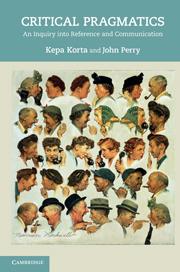Book contents
- Frontmatter
- Contents
- Preface
- Acknowledgments
- 1 Introduction
- 2 A short history of reference
- 3 Acts, roles, and singular reference
- 4 Elements of reference
- 5 Demonstratives
- 6 Context sensitivity and indexicals
- 7 Names
- 8 Definite descriptions
- 9 Implicit reference and unarticulated constituents
- 10 Locutionary content and speech acts
- 11 Reference and implicature
- 12 Semantics, pragmatics, and Critical Pragmatics
- 13 Harnessing information
- 14 Examples
- Bibliography
- Index
13 - Harnessing information
Published online by Cambridge University Press: 05 March 2013
- Frontmatter
- Contents
- Preface
- Acknowledgments
- 1 Introduction
- 2 A short history of reference
- 3 Acts, roles, and singular reference
- 4 Elements of reference
- 5 Demonstratives
- 6 Context sensitivity and indexicals
- 7 Names
- 8 Definite descriptions
- 9 Implicit reference and unarticulated constituents
- 10 Locutionary content and speech acts
- 11 Reference and implicature
- 12 Semantics, pragmatics, and Critical Pragmatics
- 13 Harnessing information
- 14 Examples
- Bibliography
- Index
Summary
Introduction
We close our book by further explaining the view of content and content properties that underlies our approach. We then use these ideas to show how the themes with which we began – language as action, communicative intentions, and content properties – form a coherent whole. We end by returning to the decoding and the intention-discovery models of interpretation.
Content
In the first chapter, we listed several categories of content properties:
Cognitive properties, where the contents are usually identified by ‘that’-clauses: Believing that London is pretty, hoping that London is pretty, knowing that Santa Cruz is east of Berkeley.
Properties of linguistic agents: saying that London is pretty, implying that Bush is from Texas.
Properties having to do with attitudes and acts where the contents are typically identified by ‘to’-clauses or gerunds rather than that-clauses (although near equivalents can usually be formulated in that format): desiring to own a Bentley, hoping to catch a plane, telling Fido to quit barking, asking a waiter to bring a wine list, regretting having gone to the store, remembering turning off the oven.
Properties whose content clause contains an interrogative rather than a declarative sentence: knowing who Tony Blair is, or asking whether Paris is larger than London.
We claim two kinds of content are basic:
– The informational content of events and states: those tracks show that a fox has been on the path, the x-ray shows that Gretchen has a broken leg.
[…]
- Type
- Chapter
- Information
- Critical PragmaticsAn Inquiry into Reference and Communication, pp. 150 - 165Publisher: Cambridge University PressPrint publication year: 2011



